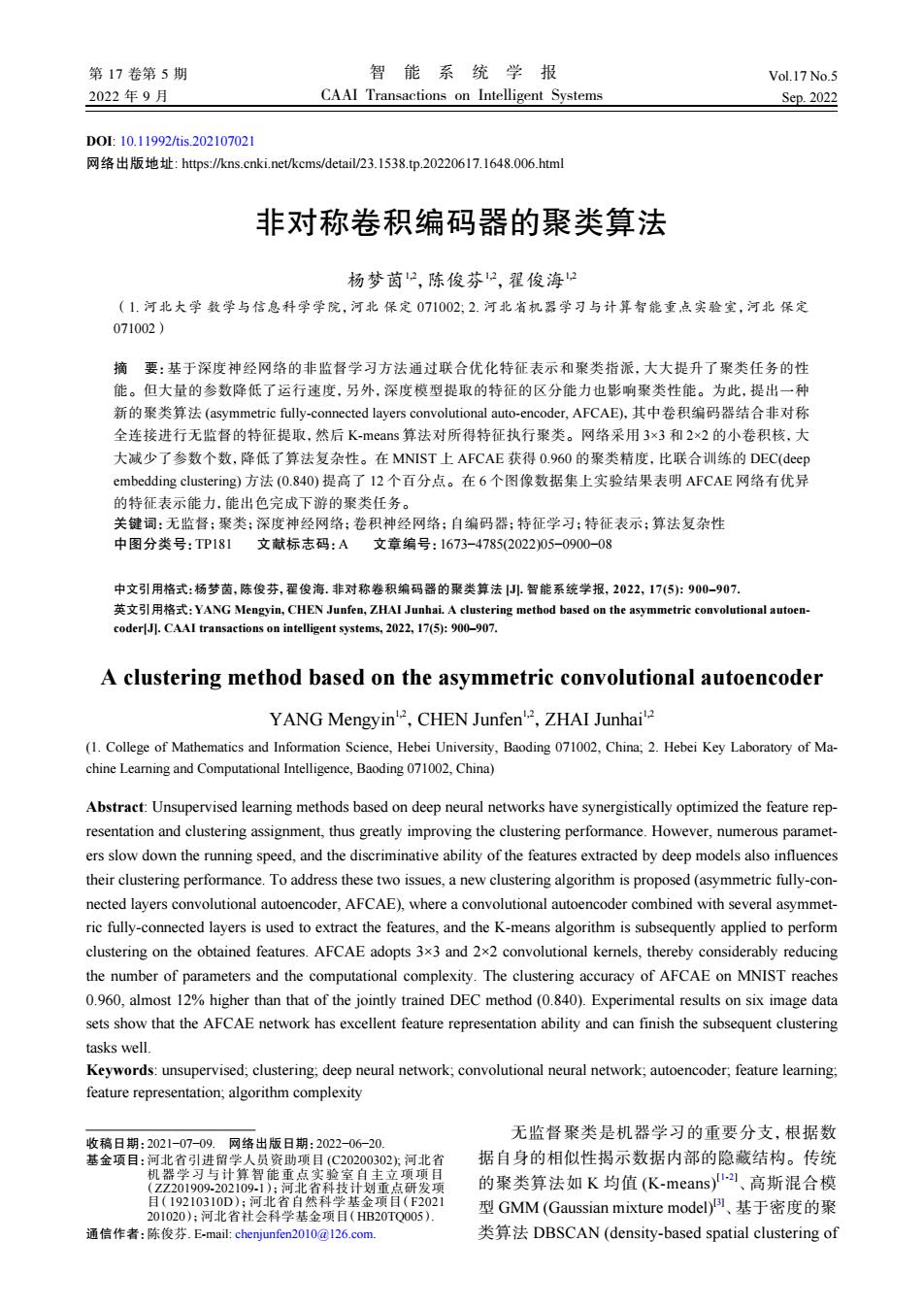正在加载图片...

第17卷第5期 智能系统学报 Vol.17 No.5 2022年9月 CAAI Transactions on Intelligent Systems Sep.2022 D0:10.11992/tis.202107021 网络出版地址:https:/ns.cnki.net/kcms/detail/23.1538.tp.20220617.1648.006html 非对称卷积编码器的聚类算法 杨梦茵2,陈俊芬12,翟俊海 (1.河北大学数学与信息科学学院,河北保定071002,2.河北省机器学习与计算智能重点实验室,河北保定 071002) 摘要:基于深度神经网络的非监督学习方法通过联合优化特征表示和聚类指派,大大提升了聚类任务的性 能。但大量的参数降低了运行速度,另外,深度模型提取的特征的区分能力也影响聚类性能。为此,提出一种 新的聚类算法(asymmetric fully-connected layers convolutional auto-encoder,AFCAE),其中卷积编码器结合非对称 全连接进行无监督的特征提取,然后K-means算法对所得特征执行聚类。网络采用3×3和2×2的小卷积核,大 大减少了参数个数,降低了算法复杂性。在MNIST上AFCAE获得0.960的聚类精度,比联合训练的DEC(deep embedding clustering)方法(O.84O)提高了I2个百分点。在6个图像数据集上实验结果表明AFCAE网络有优异 的特征表示能力,能出色完成下游的聚类任务。 关键词:无监督;聚类:深度神经网络;卷积神经网络;自编码器:特征学习:特征表示:算法复杂性 中图分类号:TP181文献标志码:A文章编号:1673-4785(2022)05-0900-08 中文引用格式:杨梦菌,陈俊芬,翟俊海.非对称卷积编码器的聚类算法J小.智能系统学报,2022,17(5):900-907. 英文引用格式:YANG Mengyin,.CHEN Junfen,,ZHAI Junhai..A clustering method based on the asymmetric convolutional autoen- coder[J].CAAI transactions on intelligent systems,2022,17(5):900-907. A clustering method based on the asymmetric convolutional autoencoder YANG Mengyin,CHEN Junfen'2,ZHAI Junhai2 (1.College of Mathematics and Information Science,Hebei University,Baoding 071002,China;2.Hebei Key Laboratory of Ma- chine Learning and Computational Intelligence,Baoding 071002,China) Abstract:Unsupervised learning methods based on deep neural networks have synergistically optimized the feature rep- resentation and clustering assignment,thus greatly improving the clustering performance.However,numerous paramet- ers slow down the running speed,and the discriminative ability of the features extracted by deep models also influences their clustering performance.To address these two issues,a new clustering algorithm is proposed(asymmetric fully-con- nected layers convolutional autoencoder,AFCAE).where a convolutional autoencoder combined with several asymmet- ric fully-connected layers is used to extract the features,and the K-means algorithm is subsequently applied to perform clustering on the obtained features.AFCAE adopts 3x3 and 2x2 convolutional kernels,thereby considerably reducing the number of parameters and the computational complexity.The clustering accuracy of AFCAE on MNIST reaches 0.960,almost 12%higher than that of the jointly trained DEC method(0.840).Experimental results on six image data sets show that the AFCAE network has excellent feature representation ability and can finish the subsequent clustering tasks well. Keywords:unsupervised;clustering;deep neural network;convolutional neural network;autoencoder,feature learning; feature representation;algorithm complexity 无监督聚类是机器学习的重要分支,根据数 收稿日期:2021-07-09.网络出版日期:202206-20. 基金项目:河北省引进留学人员资助项目(C20200302):河北省 据自身的相似性揭示数据内部的隐藏结构。传统 机器学习与计算智能重点实验室自主立项项目 (ZZ201909-202109-1):河北省科技计划重点研发项 的聚类算法如K均值(K-means)-)、高斯混合模 目(19210310D):河北省自然科学基金项目(F2021 201020):河北省社会科学基金项目(HB20TQ005). 型GMM(Gaussian mixture model))、基于密度的聚 通信作者:陈俊芬.E-mail:chenjunfen2.010@126.com 类算法DBSCAN(density-based spatial clustering ofDOI: 10.11992/tis.202107021 网络出版地址: https://kns.cnki.net/kcms/detail/23.1538.tp.20220617.1648.006.html 非对称卷积编码器的聚类算法 杨梦茵1,2,陈俊芬1,2,翟俊海1,2 (1. 河北大学 数学与信息科学学院,河北 保定 071002; 2. 河北省机器学习与计算智能重点实验室,河北 保定 071002) 摘 要:基于深度神经网络的非监督学习方法通过联合优化特征表示和聚类指派,大大提升了聚类任务的性 能。但大量的参数降低了运行速度,另外,深度模型提取的特征的区分能力也影响聚类性能。为此,提出一种 新的聚类算法 (asymmetric fully-connected layers convolutional auto-encoder, AFCAE),其中卷积编码器结合非对称 全连接进行无监督的特征提取,然后 K-means 算法对所得特征执行聚类。网络采用 3×3 和 2×2 的小卷积核,大 大减少了参数个数,降低了算法复杂性。在 MNIST 上 AFCAE 获得 0.960 的聚类精度,比联合训练的 DEC(deep embedding clustering) 方法 (0.840) 提高了 12 个百分点。在 6 个图像数据集上实验结果表明 AFCAE 网络有优异 的特征表示能力,能出色完成下游的聚类任务。 关键词:无监督;聚类;深度神经网络;卷积神经网络;自编码器;特征学习;特征表示;算法复杂性 中图分类号:TP181 文献标志码:A 文章编号:1673−4785(2022)05−0900−08 中文引用格式:杨梦茵, 陈俊芬, 翟俊海. 非对称卷积编码器的聚类算法 [J]. 智能系统学报, 2022, 17(5): 900–907. 英文引用格式:YANG Mengyin, CHEN Junfen, ZHAI Junhai. A clustering method based on the asymmetric convolutional autoencoder[J]. CAAI transactions on intelligent systems, 2022, 17(5): 900–907. A clustering method based on the asymmetric convolutional autoencoder YANG Mengyin1,2 ,CHEN Junfen1,2 ,ZHAI Junhai1,2 (1. College of Mathematics and Information Science, Hebei University, Baoding 071002, China; 2. Hebei Key Laboratory of Machine Learning and Computational Intelligence, Baoding 071002, China) Abstract: Unsupervised learning methods based on deep neural networks have synergistically optimized the feature representation and clustering assignment, thus greatly improving the clustering performance. However, numerous parameters slow down the running speed, and the discriminative ability of the features extracted by deep models also influences their clustering performance. To address these two issues, a new clustering algorithm is proposed (asymmetric fully-connected layers convolutional autoencoder, AFCAE), where a convolutional autoencoder combined with several asymmetric fully-connected layers is used to extract the features, and the K-means algorithm is subsequently applied to perform clustering on the obtained features. AFCAE adopts 3×3 and 2×2 convolutional kernels, thereby considerably reducing the number of parameters and the computational complexity. The clustering accuracy of AFCAE on MNIST reaches 0.960, almost 12% higher than that of the jointly trained DEC method (0.840). Experimental results on six image data sets show that the AFCAE network has excellent feature representation ability and can finish the subsequent clustering tasks well. Keywords: unsupervised; clustering; deep neural network; convolutional neural network; autoencoder; feature learning; feature representation; algorithm complexity 无监督聚类是机器学习的重要分支,根据数 据自身的相似性揭示数据内部的隐藏结构。传统 的聚类算法如 K 均值 (K-means)[1-2] 、高斯混合模 型 GMM (Gaussian mixture model)[3] 、基于密度的聚 类算法 DBSCAN (density-based spatial clustering of 收稿日期:2021−07−09. 网络出版日期:2022−06−20. 基金项目:河北省引进留学人员资助项目 (C20200302); 河北省 机器学习与计算智能重点实验室自主立项项目 (ZZ201909-202109-1);河北省科技计划重点研发项 目(19210310D);河北省自然科学基金项目(F2021 201020);河北省社会科学基金项目(HB20TQ005). 通信作者:陈俊芬. E-mail: chenjunfen2010@126.com. 第 17 卷第 5 期 智 能 系 统 学 报 Vol.17 No.5 2022 年 9 月 CAAI Transactions on Intelligent Systems Sep. 2022